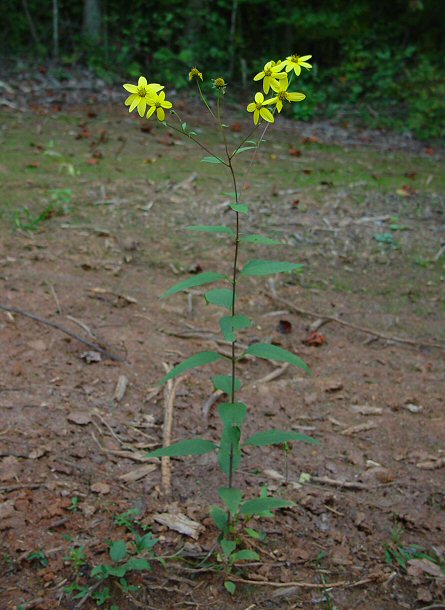Helianthus microcephalus Torr. & A. Gray
Small Woodland Sunflower

Native
CC = 8
CW = 5
MOC = 6
© DETenaglia
Helianthus microcephalus Torr. & A. GraySmall Woodland Sunflower | |
 |
Native CC = 8 CW = 5 MOC = 6 |
© DETenaglia |
|
Family - Asteraceae/Heliantheae Habit - Perennial forb with short, thick rhizomes, or lacking rhizomes, sometimes occurring in clumps. Stems - Ascending to erect, sometimes arching, few to several, to 2.5 m, smooth and glabrous below the inflorescence, often somewhat glaucous.
Leaves - Well developed along the stem, usually with 8-20 nodes, gradually reduced toward the stem tip, mostly opposite, sometimes becoming alternate upward, mostly petiolate, the petioles less than 4 cm long. Blades 4-18 cm long, 1-6 cm wide, relatively thick-textured, lanceolate to narrowly ovate (mostly 4-9 times as long as wide), flat, not folded longitudinally, rounded to short-tapered at the base, tapered to a sharply pointed tip, the margins finely toothed to nearly entire, flat, the upper surface strongly roughened with moderate, minute, stout, broad-based hairs, the undersurface moderately to densely pubescent with short, softer, loosely appressed hairs and also with sparse to moderate, sessile, yellow glands, with 3 main veins, the lateral pair branching from the midnerve well above the base of the blade, arching upward.
Inflorescences - Open clusters or panicles with few to several flowering heads.
Heads - Involucre 5-7 mm long, 8-10 mm in diameter, about as long as or slightly longer than the tips of the disc corollas, the bracts in 3 or 4 subequal, overlapping series, narrowly lanceolate, tapered to a sharply pointed, loosely ascending to spreading or recurved tip, the margins with a fringe of short, spreading to ascending hairs, the outer surface glabrous or sparsely hairy toward the base but usually lacking glands. Receptacle convex to short-conical, the chaffy bracts 5-7 mm long, narrowly oblong to narrowly oblong-oblanceolate, with 3 short-tapered, sharply pointed lobes at the tip, these straw-colored or rarely purplish-tinged, the outer surface minutely hairy toward the tip.
Flowers - Ray florets 5-8, the corolla 1.0-1.5 cm long, the outer surface usually with sparse, sessile, yellow glands. Disc florets with the corolla 4.0-5.5 mm long, the corollas yellow, the lobes minutely hairy on the outer surface. Pappus of 2 scales 1.5-2.5 mm long, these lanceolate to narrowly triangular, tapered to a sharply pointed, often minutely awnlike tip.
Fruits - Achenes 3.5-4.5 mm long, wedge-shaped to narrowly obovate, only slightly flattened but more or less bluntly 4-angled in cross-section, the surface glabrous, with fine, darker and lighter brown mottling. Flowering - August - September. Habitat - Moist or dry open woods, swampy ground along streams, thickets, sandy fields, typically in acid or clay soils. Origin - Native to the U.S. Lookalikes - Other species of Helianthus, particularly H. hirsutus, H. strumosus, and H. tuberosus. Other info. - This species has the smallest flowering heads of any of Missouri's sunflowers, rarely exceeding 3 cm in diameter. This trait, along with the relatively small number (5-8) of disk florets, serve to distinguish this species from its lookalikes. The plant is uncommon in Missouri, found in just a few counties in the southeastern corner of the state. Beyond Missouri it occurs in several Midwestern and Deep South states. Photographs taken in Brown Summit, NC., 10-3-02 (DETenaglia); also at Holly Ridge Conservation Area, Stoddard County, MO, 8-16-2021 (SRTurner). |